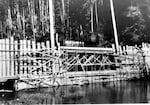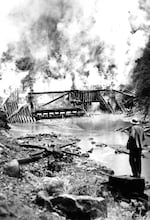
Stephen Dow Beckham
Around the same time famed photographer Carelton Watkins first captured the Columbia River Gorge with his traveling darkroom, on the south fork of the Coos River in southwest Oregon a large dam helped fuel Oregon's burgeoning timber industry.
The Tioga Dam was the largest splash dam in the Northwest. It was the first of what would grow to become 230 splash dams throughout western Oregon.
Let's start big picture. From 1849-1924, Oregon produced over 47 billion board feet of lumber production, most of it hauled out on rivers. For context, trucks carried about 4 billion board feet lumber out of the woods on forest roads in 2014.

The Tioga Dam on the South Coos River towered 52 feet high and 200 feet wide.
Stephen Dow Beckham
In the past, ax men would cut down the towering trees and guide them into flooded rivers, which were controlled by splash dams. When ready, the splash dams opened and the wood rushed down in log drives. Workers would use dynamite to carve out natural objects in the way and clear backed up trees.
The river could carried off around a million board feet of timber in a single drive.
Oregon's years of log drives ended with the Tioga, as the last standing splash dam in Oregon. Under pressure from the state and landowners, it closed in 1957. Workers burned it down in a night.
Many of the rivers changed by the log drives have healed over the past 70 years. But there are some lingering challenges.
Oregon Field Guide explores this history and what means now for some rivers in Oregon

